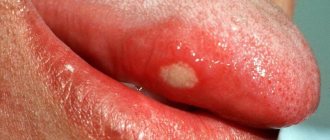Maxillofacial phlegmon: causes and dangers
The vast majority of phlegmons (more than 90%) are odontogenic in nature, that is, they arise due to a tooth that is not treated in time, destroyed by caries or periodontitis. The causative agents of inflammation - staphylococci, streptococci, anaerobic and putrefactive microorganisms - penetrate from the affected tooth root into the tissues of the perimaxillary region due to the peculiarities of the outflow of lymph and venous blood. Another difference between phlegmon and an abscess is that it develops against the background of a significant decrease in immunity, while an abscess can form in a patient with normal protective reactions of the body.
Cellulitis of the maxillofacial area is a dangerous condition that requires serious surgical intervention. The severity of the patient’s condition is determined by the degree of neglect of the process and general intoxication of the body. In addition, nerve endings are concentrated in the jaw area, so a diffuse purulent inflammatory process brings unbearable pain and physical suffering to a person. Vital functions are impaired - swallowing, chewing, speaking, breathing. And a large number of venous plexuses favors the rapid spread of the process and its transition to vital organs and systems. The most severe complications of this disease:
- phlebitis;
- thrombophlebitis;
- mediastinitis,
- abscesses of internal organs;
- meningitis;
- meningoencephalitis;
- sepsis.
Cellulitis is especially severe in children or if it is caused by anaerobic microorganisms.
Odontogenic phlegmon
The cause of the development of this kind of disease is always a dental problem. Any pathology of the masticatory organs can lead to this outcome.
Problems may arise at the following stages:
- Before tooth eruption;
- At the moment when he is already in the row;
- After removing it.
The most common cause of this disease is untreated caries. The pathological process in hard tissues, having gone through certain stages of disease development (pulpitis -> periodontitis), can lead to the development of a radicular cyst. When immunity decreases, it can fester, and then the contents surrounded by the capsule have the opportunity to go beyond its limits.
Wisdom teeth can also cause problems as they are the most advanced teeth and may not have enough space in the row. Having appeared at least half, they become vulnerable to the carious process. Under the gingival hood, which is located above the tubercles, food begins to accumulate. Then cariogenic microorganisms join this substrate and begin to ferment leftover food into organic acids. As a result, a cavity forms in the hard tissues. The wisdom tooth is anatomically designed in such a way that it is very difficult to treat, and if preservation is not practical, then it is better to remove it.
A very rare phenomenon occurs when the disease develops after tooth extraction. The following reasons may contribute to this:
- Part of the organ was left in the socket;
- Food getting into an unhealed hole;
- Permanent injury to the socket with a blood clot, followed by infection.
If any element of the tooth remains inside, then in most cases it will lead to inflammation, since it will be perceived by its own tissues as a foreign body. In addition, local immunity will be activated, which will actively produce lymphocytes. When pathogenic microflora attaches, this phenomenon can spread to nearby tissues. Therefore, it is necessary to remove everything that remains in the hole after tooth extraction.
At first, a person complains of swelling in the area of the extracted tooth and painful opening of the mouth. Throughout the course of the disease, the puffiness of the face becomes more and more. Then, every day the person’s general condition begins to deteriorate. The temperature rises, and blood tests change, which begin to indicate an inflammatory process occurring in the body.
Our team of doctors
Maxillofacial surgeon, Implantologist
Bocharov Maxim Viktorovich
Experience: 11 years
Dental surgeon, Implantologist
Chernov Dmitry Anatolievich
Experience: 29 years
Orthopedist, Neuromuscular dentist
Stepanov Andrey Vasilievich
Experience: 22 years
Endodontist, Therapist
Skalet Yana Alexandrovna
Experience: 22 years
Orthopedic dentist
Tsoi Sergey Konstantinovich
Experience: 19 years
Dentist-orthodontist
Enikeeva Anna Stanislavovna
Experience: 3 years
How not to die from a bad tooth
Cellulitis is a diffuse purulent inflammation, which, in the absence of adequate treatment, leads to death. Quite often, the cause of the formation of phlegmon is a diseased tooth. Igor Panin, head of the department, told the Sibmeda portal how to avoid becoming a victim of a deadly disease. Department of Maxillofacial Surgery of the Novosibirsk Regional Hospital.
– Igor Anatolyevich, is phlegmon a common disease?
– Phlegmons of various localizations, including those of odontogenic etiology, that is, from teeth, are quite common. Patients with phlegmon make up a significant part of the patients in our department.
- What is the reason?
– Despite the rapid development of dentistry, patients with a healthy oral cavity are not as common as we would like.
Diseased teeth are, most often, the cause of the development of severe phlegmons of the face and neck, which regularly lead to death in this group of patients - due to neglect and the development of associated complications.
Such complications include the development of chest inflammation, various types of breathing problems, sepsis, as well as some other conditions that can lead to the death of the patient.
It happens that the development of phlegmon is associated with the removal of teeth, and with the fact that the inflammatory process from the tooth, despite its removal, spreads to the surrounding tissues.
In most cases, the reason for the development of phlegmon is the lack of visits to dentists and late treatment when complications develop.
– Can phlegmon develop from pulpitis?
– It is incorrect to say that phlegmon develops as a result of pulpitis. This is not typical for pulpitis. Still, phlegmon often develops when the pulp is no longer present, and when there is an inflammatory process in the area of the roots of the teeth.
– Does the development of phlegmon often end in death for the patient?
– Unfortunately, every year people die from phlegmon of odontogenic etymology in the Novosibirsk region. I won’t say that such cases are registered every month, but every year.
Fortunately, most patients can still be cured if treated in a timely manner.
But if we talk about advanced cases, when the patient needs to be treated for complications that have already developed, then we have such patients all the time. As a rule, they are in the intensive care unit. Their recovery is a long process; the state has to invest large sums of money for such patients. The process of treating a patient with severe phlegmon can take more than a month.
– It turns out that such dangerous consequences arise simply because of a tooth that is not treated in time?
- More often. There are, of course, other causes of phlegmon - consequences of injuries, various inflammatory diseases of the tonsils, but the most serious problem is precisely those phlegmons that develop as a result of dental disease.
Cellulitis that develops from tonsils or injuries is still of a milder nature than phlegmon from teeth.
The largest group of patients are patients who sought medical help late. When a person has a toothache, he self-medicates: he rinses with soda, takes pills, but the tooth continues to ache, and the inflammatory process extends beyond the boundaries of this tooth into the surrounding tissues, with the development of severe complications.
Less often, situations arise when a patient consults a doctor to remove a diseased tooth or treat it, but despite the fact that the doctor carries out therapeutic measures, the inflammatory process progresses and the patient, as a rule, comes to us.
– How quickly does phlegmon form? This is not an instant process, is it?
– In fact, the microflora in teeth is aggressive, and the development of phlegmon can occur within hours. The speed of development depends on the general condition of the body, age, use of antibiotics and some other factors that can stop this process. But these processes are very serious, and the development of complications cannot always be predicted.
Therefore, if there is a suspicion of phlegmon of the oral cavity and neck, first of all, an urgent visit to the hospital is necessary, where a decision on further treatment tactics will be made.
– By what symptoms can one suspect phlegmon?
– As a rule, the process begins with swelling on the face or neck. The mouth may have difficulty opening, and there may be pain when swallowing. The development of phlegmon is always accompanied by fever, weakness, and sweating.
The presence of swelling on the face and high temperature is a reason to contact a dental surgeon at the clinic as quickly as possible.
In our city, you can get dental care around the clock. And the clinic doctor, even if he cannot provide assistance himself, will assess the patient’s condition and refer him to the hospital if necessary.
– How long does it take for a patient to seek medical help?
– Let’s just say that time in this case does not work for the patient. The faster the better. With timely treatment, you can get by with a smaller amount of surgical intervention. When the situation has not reached the point of phlegmon, and the inflammation is localized in the area of the tooth, it does not spread to the surrounding tissues.
Still, more often it happens like this: the tooth was removed, antibiotics were prescribed, if necessary, and the purulent process stopped there. Most of these patients are treated on an outpatient basis.
But in this group there are patients when the inflammation spreads to neighboring areas, and then the person must be hospitalized in a hospital.
– Is it possible to confuse phlegmon with another acute disease?
– There is confusion with some diseases that are also accompanied by swelling in the neck. If in doubt, it is important to contact the appropriate specialist - a dental surgeon at the clinic, first of all. He will make a decision and, if necessary, send you to the hospital.
– Which medical institutions in Novosibirsk provide assistance to such patients?
– In our city, inpatient care for patients with phlegmon is provided in three hospitals. For the adult urban population - in the department of maxillofacial surgery of the 34th hospital, for the regional population - in the Novosibirsk Regional Hospital and for the children's population - in the 3rd emergency hospital.
– How is the diagnosis of “phlegmon” made or specified?
– As a rule, the diagnosis is made primarily on the basis of clinical data. This does not require any special examination. Tomography can be performed to clarify which areas are affected by phlegmon in a given patient.
– What treatment methods are used for phlegmon?
– The only possible method of treating patients with phlegmon is surgery: wide incisions are required to eliminate the purulent process. No other has been invented yet. No pills or injections will help without surgery.
It is important to know: patients with phlegmon are not treated with antibiotics. Antibiotics are used after surgical treatment, and not instead.
Everything must be combined - surgery, antibiotics, infusion therapy, and many other procedures.
– Igor Anatolyevich, how can you protect yourself from such a dangerous disease as phlegmon?
– It is important to remember that the presence of rotten teeth in the mouth is a time bomb that can explode at any time. There is, of course, an element of luck, but I don’t recommend relying on it in this matter.
Therefore, the main preventive measure is, of course, regular visits to the dentist in order to treat carious teeth, sanitize foci of chronic odontogenic infection, so as not to lead to the development of phlegmon. After all, the strategic task is not to consult a doctor at the right time, when phlegmon has already developed, and not to allow its development, in principle.
Subscribe to our Instagram and Facebook to keep abreast of exciting events and news from the world of medicine, health and beauty.
Symptoms
Phlegmon of the perimaxillary region, unlike an abscess, develops rapidly and is characterized by severe intoxication. Its main clinical manifestations:
- infiltration on the affected area of the face or neck;
- hyperemia, swelling, soreness of the skin at the site of inflammation;
- high body temperature;
- rapid pulse;
- severe pain when chewing, swallowing, talking;
- spasm of the muscles responsible for opening and closing the mouth (trismus);
- increased salivation;
- weakness;
- chills;
- pale skin;
- loss of appetite;
- sleep disorders;
- enlargement of regional lymph nodes;
- facial asymmetry.
Periandibular phlegmon, photos of which can frighten impressionable people, is always accompanied by an increased number of leukocytes and neutrophils in the blood, a shift in the leukocyte formula to the left and an increased ESR value. The diagnostic sign of phlegmon in the blood serum is C-reactive protein. Protein and white blood cells also appear in the urine.
What are the consequences
Oral phlegmon can lead to various complications. The most severe consequence will be the development of sepsis. This condition occurs when germs travel through the blood throughout the body, colonizing internal organs. Also, the purulent process through the lymphatic and blood vessels can penetrate through their walls, and then the development of thrombophlebitis of the facial veins is possible. The surrounding tissues also do not remain unchanged. The location of a purulent focus close to the bone can provoke the development of osteomyelitis.
A threatening situation is the development of bleeding due to damage to the walls of blood vessels. Such complications arise when the process is advanced and are much more difficult to treat. Therefore, to avoid such consequences, you must immediately seek help.
Treatment
Despite the severity of the disease, in general, with timely treatment, perimandibular phlegmon has a favorable prognosis. Treatment is carried out only in a hospital setting, but at the initial stage everything is often limited to the use of conservative methods - antibiotic therapy, the prescription of restoratives, vitamins, and a special diet. But if the process has already started and the spread of infection is observed, complex surgical treatment is indicated, which includes the following points:
- opening the inflammation site under general anesthesia;
- cleansing the wound from pus;
- installation of drains for drainage of wound contents;
- daily treatment with bactericidal solutions;
- powerful antibiotic therapy - often a complex of several drugs is prescribed;
- detoxification of the body;
- use of antipyretic and painkillers;
- prescription of immunomodulating, restorative agents, vitamins;
- physiotherapy – ultraviolet irradiation, UHF, magnetic therapy, etc.
If treatment is successful and there are no complications, the patient’s recovery occurs on average in 14-21 days.
Diagnosis of oral phlegmon
Pathology can be diagnosed through external examination and examination of the oral cavity. The doctor collects complaints and detailed information about what preceded the disease. Visually identifies the source of infection. If the purulent process is located in the superficial layers, then diagnosis is usually not difficult. But if the pus is localized in deep places, then additional clinical and laboratory tests will need to be done. And also carry out microbiological seeding in order to establish the microbial flora. This is necessary in order to prescribe appropriate antibacterial drugs in the future.










